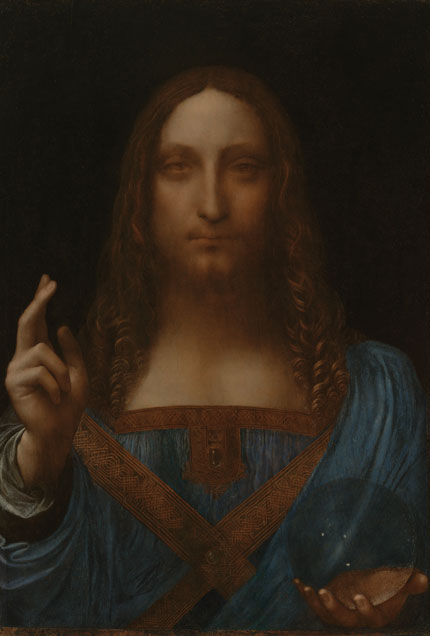art
The Lost Leonardo
A master’s priceless work is found
by Megan Doll / GSAS ’08
Dianne Dwyer Modestini had just finished cleaning and restoring Andrea del Sarto’s Madonna and Child when, in 2005, gallerist and art historian Robert Simon brought a new project to her Upper East Side home. The recently acquired work, a 16th-century oil painting on a walnut panel, was believed to be a common copy of Leonardo da Vinci’s lost Salvator Mundi (Savior of the World). Though damaged and obscured by crude overpaint from earlier attempts at restoration, both Modestini and Simon could see passages of extremely high quality.
As she set about retouching it, Modestini, senior research fellow and paintings conservator in the Conservation Center of NYU’s Institute of Fine Arts (IFA), uncovered a work of remarkable delicacy. She found the painter’s nimble technique difficult to imitate—the final glazes were so finely applied that they appeared blown on rather than painted with a brush. Three years into the restoration process, as she labored over the subtle transition between tones in Christ’s damaged upper lip, Modestini turned to a high-resolution photograph of Leonardo’s Mona Lisa and found a shocking similarity. “I suddenly realized that the Salvator Mundi couldn’t be by any painter other than Leonardo,” she explains. “The transition is literally imperceptible at close range.” Anxious to find further proof, she noted a similar correspondence in Christ’s eyes and nose; the well-preserved curls of his hair were nearly identical to Leonardo’s St. John the Baptist. With her heart pounding and her hands trembling, Modestini set down her brushes, closed her jars, and left the IFA for home.
The discovery of Leonardo’s Salvator Mundi—now unanimously authenticated by leading Leonardo experts—changes the artist’s surviving oeuvre as we know it. Owing to his at times unfortunate experimentation with pigments, there were only 14 known Leonardo oil paintings prior to the discovery of the Salvator Mundi. “To add another painting to that number is tremendous,” Simon says. Though not for sale, the piece would fetch a rumored $200 million on today’s art market, according to ARTnews.
While there remains some question as to whether the work was painted in Florence or Milan, the panel will make its public debut at the National Gallery in London in an exhibition titled “Leonardo da Vinci: Painter at the Court of Milan.” A documentary film of the same name, which will coincide with the exhibit’s November opening, touches on the discovery of the lost work.
The provenance of the piece remains murky. Unsubstantiated theories suggest that the panel was created for France’s Louis XII circa 1500. The first documented owner of the painting, however, was King Charles I of England; the work was recorded in his collection in 1649. Later owned by Charles II and the Duke of Buckingham, all trace of the painting is lost between its auction by the Duke of Buckingham’s son in 1763 and its acquisition in 1900 by art connoisseur Sir Francis Cook, whose descendants auctioned it at Sotheby’s in 1958. Thought to be only a copy, the work was sold for a mere £45 and was part of an American collection until 2005, when it was purchased at an estate sale by the current owners, who wish to remain anonymous.
The panel arrived at Modestini’s home in poor condition. Earlier restoration attempts had yielded dubious results: At one point restorers had repaired the cracked and bowed panel by using stucco fill, gluing it to another backing, and painting over the suture. When Modestini removed the layers of varnish and overpaint with a mixture of acetone and petroleum spirits, she found the original paint to be quite damaged. She also uncovered an interesting pentimento (vestiges of an artist’s reconsidered compositional ideas) on Christ’s blessing hand: a layer of bright pink underpaint indicating that the thumb was originally laid in at a more vertical position. For Simon, it was this evidence of the artist’s revision that convinced him of Leonardo’s authorship. (This pentimento was photographed but eventually covered in the retouching process, as per Leonardo’s intention.)
Beginning in 2007, the panel was presented to a select group of connoisseurs during various phases of its restoration. In 2008, the painting was studied at both the Metropolitan Museum of Art in New York and the National Gallery in London, where it was compared to Leonardo’s Virgin of the Rocks by curators, historians, and heavyweight Leonardo scholar Martin Kemp. “Walking into the room I thought, Ah! This is really something,” recalls Kemp, Oxford University Emeritus Research Professor in the History of Art, who, as a Leonardo authenticator, dashes the hopes of would-be discoverers on an almost weekly basis. Kemp says that it is a clear match in terms of technique, from the way the flesh tones are laid in with thin veils of glosses to the artist’s use of his fingers in the paint on Christ’s forehead.
The quality of the painting also far surpasses that of any known copies both in terms of technique and composition. “If you look at the globe in Christ’s left hand, you find so much more detail,” Simon avers. “You can see inclusions and the refractions of light in the rock crystal.” Kemp sees this crystalline sphere as a hallmark of Leonardo’s esprit: It evokes not merely the world but the cosmos, transforming the painting’s subject. “Leonardo’s paintings, particularly ones of single figures, have this very hypnotic quality,” Kemp explains. “The Salvator Mundi is a momentous image.”
Though not for sale, the piece would fetch a rumored $200 million on today’s art market.







